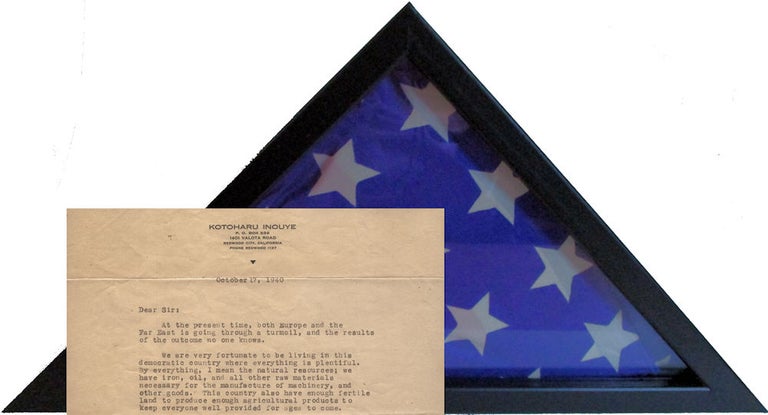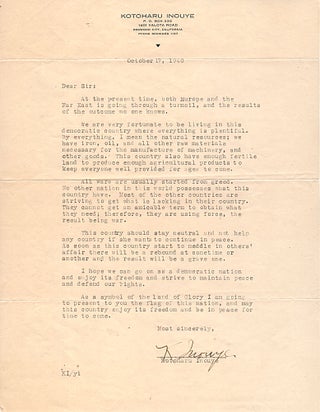A flag and letter presented to an official or journalist by a California Issei who would later be arrested and incarcerated by the FBI on December 7, 1941
Redwood City, California: October 15, 1940. Unbound. This typed letter, dated 17 October 1940 and signed by a prominent Issei member of California's Japanese-American community presents a 2' x 4' silk U.S. flag to an unnamed person, presumably a government official or journalist. Both are in nice shape; the display case is not original nor part of this lot.
The letter reads in part:
"At the present time, both Europe and the Far East is going through a turmoil, and the results of the outcome no one knows. . .. We are very fortunate to be living in this democratic country where everything is plentiful. . .. Most countries are striving to get what is lacking in their country. They cannot get amicable term to obtain what they need; therefore, they are using force, the result being war. This country should stay neutral and not help any country if she wants to continue in peace. As soon as this country start to meddle in others' affair there will be a rebound . . . and the result will be a grave one. . .. As a symbol of the land of Glory I am going to present to you the flag of this nation, and may this country enjoy its freedom and be in peace for time to come." Very good. Item #009473 Inouye's flowery words about our "democratic land of Glory" partially veil a duplicitous intent directly related to the Japanese Foreign Ministry's effort to stem the tide of adverse publicity Japan was receiving in the American press. What Inouye euphemistically referred to as "turmoil" was Germany's conquest and brutal occupation of Western Europe. More to the point of this letter, the "turmoil" was also Japan's imperialist attempt to conquer China and Southeast Asia. Additionally, Inouye's plea for U.S. neutrality fails to mention that the Axis Pact, i.e., the Tripartite Treaty, was signed just a few days before. In it, Nazi Germany, Fascist Italy, and Imperial Japan pledged to support each other in their wars of conquest and subjugation while formally acknowledging that Japan was entitled to rule all of Asia. Considering this and, in hindsight, Japan's treacherous sneak attack on Pearl Harbor, Inouye's 'suggestion' to "stay neutral" or expect "grave" consequences seems possibly to be more of a threat than a cautious recommendation.
Inouye was an ambitious son from a Samurai family. He had wanted to become a naval officer like his older brother. However, after being turned down by the Japanese Naval Academy, he immigrated to California where he established a nursery in Redwood City. He became very active in the quasi-official Japanese Associations that controlled most aspects of Issei life through tiered relationships with the Imperial Government. The Associations emphasized Japanese patriotism, churned out pro-Japanese military propaganda, promoted anti-Chinese hatred, and purchased equipment for the Japanese military.
No doubt, Inouye's samurai heritage, his brother's service in the Japanese Navy, his leadership in Japanese Associations, and this letter brought him to the attention of the FBI as the tension between Japan and the United States grew, especially after President Roosevelt directed the FBI to coordinate surveillance of potentially dangerous aliens. Within hours of the Japanese sneak attack on Pearl Harbor, FBI agents appeared at Inouye's home where, after a search, he was taken into custody as part of a sweep that included German, Italian, and Japanese nationals (Inouye was not a U.S. citizen) suspected of being or of being sympathetic to Axis agents. FBI records indicate that during this sweep, the foreign nationals were arrested if they possessed certain cameras, weapons, signaling equipment, or short-wave radios. Although records don't reveal what Inouye possessed, a local newspaper reported his son agreed that Inouye's arrest was the proper thing to do. This comment is indicative of a growing generational split among Japanese immigrants. Issei loyalty generally went to Japan and Nissei loyalty to the United States.
Inouye and two German nationals apprehended at the same time were first taken to a former immigration office barracks on Angel Island in San Francisco Bay, and then moved to a U.S. Justice Department detention camp at Sharp Park (now in the city of Pacifica) where about 135 other suspected agents were also held. From there, Inouye was moved through several Department of Justice and U.S. Army detention camps (the Santa Fe and Lordsburg camps in New Mexico, the Ft. Lincoln camp in North Dakota, and Ft. Missoula camp in Montana), which should not be confused with the well-known concentration camps that were later operated by the War Relocation Authority (WRA). At the Ft. Missoula camp, additional screenings were conducted and most Japanese who had been arrested were deemed harmless and released to the WRA. Inouye was not released; he was retained at Ft. Missoula. While there, he was diagnosed with Parkinson's Disease and transferred to the Mayo Clinic for treatment. Following treatment at the clinic, Inouye was not sent back to a foreign agent camp but was instead transferred to the WRA's Topaz concentration camp outside of Salt Lake City, Utah where his family had been interned. After the war, Inouye, along with his family returned to California.
For more information see: Muzac's "Inouye, Kotoharu" at the San Mateo County Historical Association Online, Ichioka's "Japanese Immigrant Nationalism" in California History (Fall, 1990), multiple articles in the online Densho Encyclopedia, "193 Aliens . . . Moved to Sharp Park Camp to Ease Immigration Station" at the Virtual Museum of the City of San Francisco, various articles in Okihiro's Encyclopedia of Japanese American Internment, the online History of Angel Island Immigration Station by the Angel Island Immigration Station Foundation, FBI Memorandum "Internal Security Alien Enemy Control", "Historic Resource Evaluation by the City of Palo Alto #16252H (Draft)", Baker's "Homefront Redwood City – A small town faces a big war" online at Humboldt State University, and Yenne's Panic on the Pacific.
A rare Issei Japanese propaganda letter and presentation flag; possibly unique although it is possible that Inouye presented additional letters and flags to other journalists or officials. At the time of this listing, nothing remotely similar is for sale in the trade, and Rare Book Hub shows nothing similar ever being sold at auction. As well, OCLC shows no institutional holdings of other examples, nor any else like them. However, the Hoover Institution has a partially cataloged "Kotoharu Inouye Family Collection" that appears to consist of only books and other publications but may be found to contain other propaganda material as its processing progresses.
Price: $1,000.00







